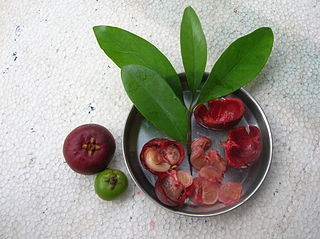
Azadirachta indica, commonly known as neem, nimtree or Indian lilac, and in Nigeria called dogoyaro or dogonyaro, is a tree in the mahogany family Meliaceae. It is one of two species in the genus Azadirachta, and is native to the Indian subcontinent and most of the countries in Africa. It is typically grown in tropical and semi-tropical regions. Neem trees also grow on islands in southern Iran. Its fruits and seeds are the source of neem oil.

Tamarind is a leguminous tree bearing edible fruit that is indigenous to tropical Africa. The genus Tamarindus is monotypic, meaning that it contains only this species. It belongs to the family Fabaceae.

The Annonaceae are a family of flowering plants consisting of trees, shrubs, or rarely lianas commonly known as the custard apple family or soursop family. With 108 accepted genera and about 2400 known species, it is the largest family in the Magnoliales. Several genera produce edible fruit, most notably Annona, Anonidium, Asimina, Rollinia, and Uvaria. Its type genus is Annona. The family is concentrated in the tropics, with few species found in temperate regions. About 900 species are Neotropical, 450 are Afrotropical, and the remaining are Indomalayan.

The genus Mitrephora, of family Annonaceae, comprises around 40 species of trees and shrubs found in tropical Asia and northern Australasia. The area of distribution extends from China in the North down to Queensland, Australia in the South. The genus is widely found in southern India and Southeast Asia. It reaches a maximum of diversity in Borneo and the Philippines.

Cannabis indica is an annual plant in the family Cannabaceae. It is a putative species of the genus Cannabis. Whether it and Cannabis sativa are truly separate species is a matter of debate. The Cannabis indica plant is cultivated for many purposes; for example, the plant fibers can be converted into cloth. Cannabis indica produces large amounts of tetrahydrocannabinol (THC). The higher concentrations of THC provide euphoric effects making it popular for use both as a recreational, alternative medicine, and a clinical research drug.

Graphium nomius, the spot swordtail, is a butterfly found in South and Southeast Asia that belongs to the swallowtail family. The species was first described by Eugenius Johann Christoph Esper in 1793. One of the grandest sights is a host of spot swordtails mud-puddling or swarming around a flowering forest tree.

Graphium doson, the common jay, is a black, tropical papilionid (swallowtail) butterfly with pale blue semi-transparent central wing bands that are formed by large spots. There is a marginal series of smaller spots. The underside of wings is brown with markings similar to upperside but whitish in colour. The sexes look alike. The species was first described by father and son entomologists Cajetan and Rudolf Felder.

Monoon longifolium, the false ashoka, also commonly known by its synonym Polyalthia longifolia, is an Asian small tree species in the family Annonaceae. It is native to southern India and Sri Lanka, but has been widely introduced elsewhere in tropical Asia. This evergreen tree is known to grow over 20 m. in height and is commonly planted due to its effectiveness in alleviating noise pollution. It exhibits symmetrical pyramidal growth with willowy weeping pendulous branches and long narrow lanceolate leaves with undulate margins.
Miliusa amplexicaulis is a species of plant in the family Annonaceae. It is a tree endemic to Peninsular Malaysia, between Kedah and Perak.

Miliusa is a genus of plants in family Annonaceae. Species have been recorded from tropical and subtropical Asia to northern Australia.
Miliusa parviflora is a species of plant in the family Annonaceae. It is endemic to Peninsular Malaysia. It is threatened by habitat loss.
Miliusa zeylanica is a species of plant in the Annonaceae family. It is endemic to Sri Lanka.
Miliusa horsfieldii is a species of plant in the Annonaceae family. It is recorded from China and Indo-China. It is threatened by habitat loss.

Mangifera indica, commonly known as mango, is a species of flowering plant in the family Anacardiaceae. Mangoes are believed to have originated from the region between northwestern Myanmar, Bangladesh, and India. It is a large fruit-tree, capable of growing to a height and crown width of about 30 metres (100 ft) and trunk circumference of more than 3.7 metres (12 ft).

Garcinia indica, a plant in the mangosteen family (Clusiaceae), commonly known as kokum, is a fruit-bearing tree that has culinary, pharmaceutical, and industrial uses.
Vateria indica oil is extracted from the seeds of the Vateria indica plant, a species in the family Dipterocarpaceae. The Vateria indica plant is indigenous to the Western Ghats, Kerala and Tamil Nadu regions of India. It thrives in the evergreen forests, surviving up to 800 meters above sea level. Oil from the seeds of the plant is extracted through a chemical refining process which makes the plant edible.

Goniothalamus griffithii is a species of plant in the family Annonaceae. It is native to Myanmar and Thailand. Joseph Dalton Hooker and Thomas Thomson the British botanists who first formally described the species, named it in honor of William Griffith, another British botanist who collected the specimen they examined.

Mitrephora heyneana is a species of plant in the family Annonaceae. It is native to India and Sri Lanka. Joseph Dalton Hooker and Thomas Thomson, the British botanists who first formally described the species under the basionym Orophea heyneana, named it after Benjamin Heyne a German botanist who collected and described many plant species from India.

The Malmeoideae are a subfamily of trees and other plants of the family Annonaceae.
Miliusa macrocarpa is a species of plant in the family Annonaceae, that is native to Nepal and India.













